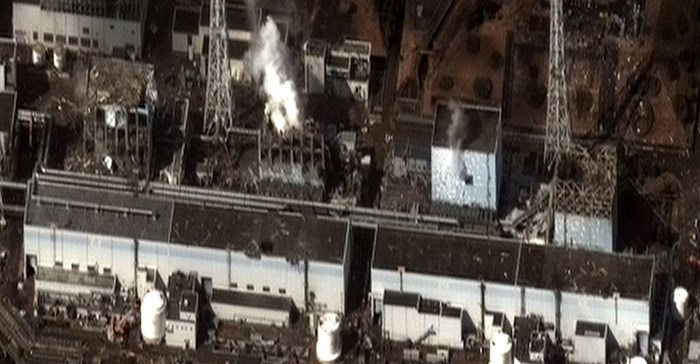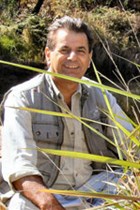On 11 March 2011 at 05h46 GMT one of the worst disasters in human history struck Japan. A massive earthquake measuring 8.9 on the Richter scale, unleashed a huge tsunami that critically disabled three reactors at the Fukushima Daiichi nuclear power plant.
An unstoppable wall of water crashed through Japan's eastern coastline, sweeping away buildings, boats, bridges, cars and people miles inland and killing 16,000 people. More than 50 aftershocks followed - seven at least 6.3 on the Richter scale. As if the earthquake and tsunami were not enough, human error compounded the problem at Fukushima. The nuclear plant didn't stand a chance. It cracked, sending radioactive plumes into the atmosphere, and tons of highly dangerous water leaked into the Pacific Ocean.
Today, four years later, 400 tons of radioactive water still pours into the Pacific every day. Radiation scientists and nuclear engineers say the scale of the disaster is incalculable. Fish bleeding through their scales are already washing up on the west coast of the USA, and the Japanese fishing industry has come to a virtual halt.
What scientists are saying
Many radiation scientists and nuclear engineers say Fukushima is by far the biggest disaster in human history and could amount to an eventual extinction event. They argue that elevated radiation levels in the sea and the air pose a serious threat to all forms of life on earth and that the cover-up is unacceptable. On the other hand, denialists say the problem is grossly exaggerated and that the risk to global health has been blown totally out of proportion. Then there is disinformation.
Where does the truth lie?
Dr Helen Caldicott, medical specialist and nuclear expert, says if another earthquake hits Fukushima, (statistically probable in the next five years), then she would advise those in North America who can, to move to the southern hemisphere if they want to reduce the real risk of radioactivity-induced cancer, strokes, leukemia and heart attacks. Radiation scientist Dr Leuren Moret, nuclear engineer Dr Arnie Gundersen and Dr Masaru Emoto agree that Fukushima is the worst disaster that has ever befallen humanity.
The massive cover-up of this disaster is a story on its own. But whatever the truth, it makes sense to learn how best to protect ourselves. As the earth is a closed ecosystem, Fukushima is clearly a problem of planetary proportions. We should all be aware of its probable consequences and build up our resistance to what is becoming an increasingly radioactive planet.
How radioactivity affects our health
Radioactivity is a silent, invisible killer. We cannot detect it with any of our five senses. It kills mainly by causing cell mutation at the DNA/chromosome level. One scientist described radioactive contamination as microscopic daggers piercing and damaging healthy cells. There is no safe dose.
Even low levels of radiation can cause cancer, organ and heart failure as well as strokes. Although initially unnoticeable, radiation damage causes multiple harmful effects in the body. Carcinogens are not necessarily immediately toxic, thus their effect can be slow and insidious which is exactly how most cancers develop.
Protection from radiation
Assuming the Fukushima disaster will have planetary consequences, let's look at how we can best protect ourselves from this deadly pollution which will be with us for many years to come.
If you suspect any radiation exposure, seek medical attention immediately. Here are several natural remedies for radiation exposure as advised by the USA-based Global Healing Centre, with input from other experts.
1. Iodine
Radiation has a direct effect on the thyroid gland, prohibiting its ability to create iodine, a key player in healthy DNA integrity, immune function, metabolic and endocrine balance, as well as cardiovascular health. However iodine only protects against radioactive iodine, not against other radioactive isotopes.
2. Potassium
In addition to radioactive iodine, the body may also be exposed to a radioactive isotope known as Cesium-137. Potassium in the diet may not be enough, but with supplementation it can play a major role in protecting the body and thyroid gland.
3. Calcium and magnesium
Each of these essential minerals can decontaminate a form of nuclear waste known as Strontium 90. Dr. Linus Pauling recommends calcium supplementation as it can lower Strontium absorption by up to 90%.
4. Dimethylsulfoxide (DMSO)
Dimethylsulfoxide is an antioxidant sulphur compound. A study undertaken at the School of Medicine at the Yokohama City University in Japan found that DMSO actively detoxifies the body and protects against cell destruction, as well as DNA aberrations in mice exposed to radioactive substances.
5. Zeolite and other clays
Ingesting this clay enables zeolites to bond to and remove nuclear waste at the cellular level. One European study found that Zeolite clay was an effective decontaminate for animals affected by the nuclear waste disaster in Chemobyl. Other clays include Kaolin, Red Clay, Bentonite and Fuller's Earth. French Green Clay is another absorptive clay shown to possess the ability to rid the human body of radiation, toxic metals and chemical residues.
6. Activated charcoal
This is another substance heralded for its absorption properties. Studies show that charcoal possesses the unique ability to neutralise radiation, and that 10 grams of charcoal can neutralise up to seven grams of toxic material.
7. Papain
Papain is a cysteine hydrolase extracted from papaya fruit known for its ability to reduce toxicants. In one laboratory study on rats, it was found that half of rats supplementing with papain could survive a lethal amount of radiation, whereas control rats did not survive.
8. Bee pollen
Initial evidence suggests that bee pollen may significantly lower the negative side effects of radiation exposure, in particular that of radium, x-rays and cobalt-60 radiotherapy. Because exposure to radiation lowers many of our body's vital substances such as white and red blood cells and antibodies, bee pollen is a natural way of boosting these vital functions.
9. Beetroot
Upon radiation exposure, the body's blood haemoglobin is broken down. Studies show that beetroot is a natural remedy for radiation, and can help the body in rebuilding damaged haemoglobin. In fact, animal lab studies have shown that rats eating a diet heavy in beet pulp were able to more effectively reduce the effects of radioactive Cesium-137 than rats who did not eat the vegetable. The study revealed that the beet-eating rats absorbed and detoxified up to 100% more effectively than the control group animals.
10. Cold-pressed organic vegetable oils
Oils such as sesame oil, extra virgin olive oil and coconut oil also help pull radiation out of the body. Sources recommend drinking four ounces of oil if you have been exposed. Not only do the lipids in the oils bind the toxins, they also offer a protective layer on cellular membranes.
11. Organic Brewers Yeast
Sources recommend using organic Brewers yeast for protection against radiation exposure. Brewer's yeast not only protects but repairs cellular damage after exposure.
12. Organic Germanium-132
This is an oxygen-rich, free-radical scavenging organic compound. When we are exposed to radiation, the rays release harmful electrons that kill blood cells (haemoglobin). Organic Germanium -132 results in a strong reduction in cell death, especially in those cells exposed to Cesium-137 and gamma rays.
13. Medicinal marijuana
This is endorsed by many scientists including Dr Emaru Emoto as having remarkable cancer protection properties. It has already been legalised in many countries.
Glimmer of hope
In spite of controlled mainstream media not disclosing the extent of the disaster, one gets the feeling that a groundswell of awareness is gradually rising, if only via platforms such as the Internet and YouTube.
References:
1. New York Times, a controlled media. http://www.nytimes.com/2012/07/16/us/politics/latest-word-on-the-campaign-trail-i-take-it-back.html?_r=4&pagewanted=all&
2.Radiation scientists criticize World Health Organisation: http://www.greenpeace.org/international/en/press/releases/World-Health-Organisation-downplays-health-impacts-of-Fukushima-nuclear-disaster/
3.World Nuclear Association. http://www.world-nuclear.org/info/Safety-and-Security/Radiation-and-Health/Nuclear-Radiation-and-Health-Effects/
4. Radio-protective Effects of Dimethyl Sulfoxide in Golden Hamster Embryo Cells Exposed to Gamma Rays at 77 K, Protection from Lethal, Chromosomal, and DNA Damage. Masami Watanabe, Masao Suzuki, Keji Suzuki, Yuji Hayakawa; and Tetsuo Miyazaki
5. Division of Radiation Biology, School of Medicine, Yokohama City University, 3-9 Fukuura, Kanazawa-ku, Yokohama 236, Japan, and Department of Synthetic Chemistry, Faculty of Engineering. Nugoya University, Chikusu-ku Nagaya 464, Japan.
6. Nuclear Emergency Tracking Centre (USA) http://www.netc.com/




































